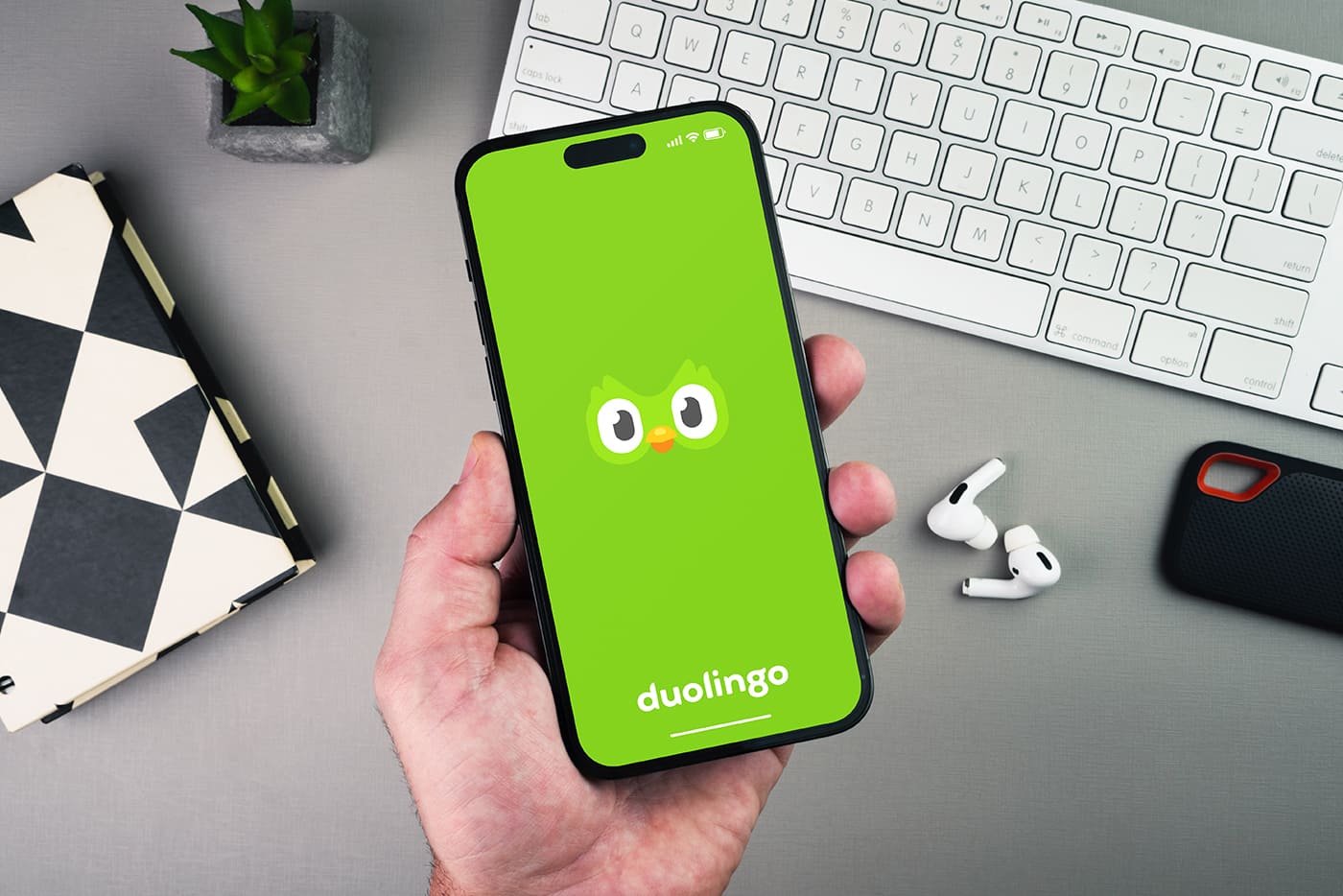The Amazing Ways Duolingo Is Using AI And GPT-4
10 May 2023
Duolingo is a leading educational technology company specializing in app-based learning. It’s also a pioneer in the field of educational artificial intelligence (AI) and recently partnered with OpenAI in order to become one of the first to offer GPT-4, its latest language model, to its customers.

OpenAI’s GPT technology has recently become familiar to millions, thanks to its ChatGPT app, which is said to have built the fastest-growing user base of all time. GPT-4 has only just recently been made available in a handful of applications, including the newly launched paid-for version of ChatGPT, the latest version of Microsoft’s Bing search engine, and as of this month, the latest version of Duolingo’s own language platform – Duolingo Max.
This is far from the start of the company’s journey with AI, though. Since its founding in 2011, its mission has been to create a “virtual language tutor” that makes language learning available to anyone, anywhere, at any time.
So let’s take a look at some of the ways that it has used AI over the years, as well as some of its latest AI-powered services enabled by GPT-4.
Personalized Learning, Automated Feedback, and English Testing
Duolingo's mission is to create the ultimate virtual language tutor, and in order to achieve this, it has to be able to cater to every one of its 500-million-plus students as an individual. This was one of the first applications of AI within the organization. Its students collectively complete around one and a quarter billion exercises on the platform every day, and data from every one of those is captured and analyzed using machine learning (ML) algorithms in order to understand how people learn and how the app could be used to improve the way they absorb new information.
Klinton Bicknell, head of AI at Duolingo, tells me, “these exercises give us a better look into what our learners know.
“Then we can use that data through machine learning models to figure out how to teach better and keep people more engaged.”
Another key use case at Duolingo revolves around creating interactive learning experiences. An example of this is automated feedback on the speech and grammar exercises that students are asked to complete. This gives users of the app platforms real-time feedback on the way they are using language as well as tips on how it could be improved.
AI is also extensively used across the company’s English testing system, which is used by over 4,000 institutions, including universities, colleges, and government organizations, to assess the competency of non-native speakers. Here, AI is used during remotely-administered tests carried out over webcam to detect different methods of cheating that candidates may attempt. It also automatically creates test items, assesses the level of difficulty of its tests, automatically grades candidates, and reviews overall performance before test scores are released.
How is GPT-4 Used?
With its partnership with OpenAI, Duolingo becomes one of the first third-party organizations to officially license and release a GPT-4 powered product.
GPT-4 is said to be significantly more powerful and sophisticated than GPT-3, which many people reading this will be familiar with, thanks to ChatGPT. It is reported to have been trained on one trillion parameters (pieces of information), compared to GPT-3’s 175 billion. This means it is capable of giving more detailed, accurate, and fluent answers to the questions it’s asked.
Bicknell tells me, "It's very exciting … we were blown away by how powerful the model was, and we immediately sat down and said, ok, with a large language model (LLM) this powerful, what kinds of things have we wanted to do in the past … that the tech just wasn’t there for?”
Bicknell’s team settled on two initial use cases, which are now available to users of the app.
The first is a role-playing feature that allows users to interact with an AI-powered persona and carry out various learning-focused tasks. One example involves conversing with an AI barista in a Parisian café. Users are able to order drinks, specify how they would like them to be made, and converse with the barista on a number of different subjects. In order to make the experience more engaging, the characters are designed as fully fleshed-out personas with their own personality and backstory that the learners can find out about through conversing and interacting.
The second GPT-4-enabled feature that’s already been made available is called Explain My Answer. This lets users get an explanation about why an answer they have been given to a question may have been graded as correct or incorrect and receive a detailed, personalized explanation just as if they were sitting and talking to a human tutor.
Bicknell says, "This is a very helpful feature …we're really pushing Duolingo closer to our ideal of being everyone's personalized tutor in ways that we haven't been able to do before – we're very excited about how these features will help people's language learning."
Working with OpenAI
Developing these features involved building a close working relationship with AI and data engineers and software developers at OpenAI. In fact, something of a symbiotic relationship quickly emerged from the working practices, with both companies providing feedback on their use cases and operations that were used to mutually improve the operations and user experience of their products.
Bicknell tells me, "It was a long process … the very basic prototyping … didn't take long at all …[Explain My Answer] was put together in a day.
“The harder part, and the much larger part of work … is that the basic prototype often went wrong in various ways. So … a lot of work was figuring out how to measure when things were going wrong, how can we reduce how likely it is that things go wrong.”
This involved generating and labeling huge amounts of data, which was then used to refine the prompts (questions) that were sent to the LLM. This data was then used to refine the pre-release version of the GPT-4 model that the Duolino team was working with.
Uses were also found for Duolingo’s existing first-party AI algorithms – mainly to ensure that conversations with the GPT-4 powered bots, such as the AI barista, stayed on track.
As was seen when Microsoft’s Bing initially launched, providing us with our first glimpse at the power – and in some cases, unpredictability – of GPT-4, users quickly found ways to create unexpected and, in some cases, undesirable results.
To stop its own characters from being subverted in this way, AI routines are used to ensure the conversation is, broadly speaking, remaining focused on relevant topics. If not, they can be gently steered back toward the relevant task.
"We have a lot of AI models on top of that working out, are things on task?" says Bicknell.
The aim is to provide an immersive, conversational experience while keeping users safe and engaged with the learning activities.
The Future of AI at Duolingo
The success of Duolingo’s AI projects so far, including its latest achievements with GPT-4, means that AI will remain its priority when it comes to growing the business, creating new user experiences, and achieving the mission of becoming the world’s personal language tutor.
New implementations on the horizon include putting AI to work and generating course content. "People always want more courses and want them to cover more advanced topics," Bicknell tells me.
“This has been a constraint in the past … we want to make sure they’re achieving the highest standards of learning, and that’s a very slow and expensive process.”
Generating new course content has traditionally been a bottleneck – and this is one job in particular that the present-day generation of language models has proven to be highly efficient at.
“They’re creative and can help generate a lot of exercises. So we’re exploring incorporating that into our workflows”, says Bicknell.
More progress is also being made with integrating GPT-4 into the company’s English testing system. Specifically, research is ongoing into ways to determine a test candidate’s language proficiency from just a small sample of their writing.
And, of course, delving deeper into the possibilities of personalization remains a top priority. The ultimate goal is to become increasingly good at understanding what can be learned from a user’s responses and how it can be leveraged to keep that particular user engaged and satisfied that they’re receiving a valuable learning experience.
Overall I believe that this strategy provides hugely valuable insight into how AI will become an important aspect of educational systems around the world, both online and in classroom-based learning. In all settings, understanding how personalization, engagement, and experience affect our ability to teach and learn has the potential to be truly transformative, making learning more effective, rewarding, and accessible for future generations.
You can click here to watch my webinar with Klinton Bicknell, head of AI at Duolingo, where we delve deeper into the potential implications of AI on the future of education.
Related Articles
AI Agents Lead The 8 Tech Trends Transforming Enterprise In 2026
By now, “smart” versions exist of just about every home appliance, gadget and gizmos we can think of. However, manufacturers continue[...]
The 8 Data Trends That Will Define 2026
By now, “smart” versions exist of just about every home appliance, gadget and gizmos we can think of. However, manufacturers continue[...]
7 Quantum Computing Trends That Will Shape Every Industry In 2026
By now, “smart” versions exist of just about every home appliance, gadget and gizmos we can think of. However, manufacturers continue[...]
The Next Giant Leap For AI Is Called World Models
By now, “smart” versions exist of just about every home appliance, gadget and gizmos we can think of. However, manufacturers continue[...]
7 Revolutionary Space Tech Trends That Will Transform Life On Earth In 2026
By now, “smart” versions exist of just about every home appliance, gadget and gizmos we can think of. However, manufacturers continue[...]
4 Tech Trends That Will Shape 2026 And The Breakthroughs Powering Them
By now, “smart” versions exist of just about every home appliance, gadget and gizmos we can think of. However, manufacturers continue[...]
Sign up to Stay in Touch!
Bernard Marr is a world-renowned futurist, influencer and thought leader in the fields of business and technology, with a passion for using technology for the good of humanity.
He is a best-selling author of over 20 books, writes a regular column for Forbes and advises and coaches many of the world’s best-known organisations.
He has a combined following of 4 million people across his social media channels and newsletters and was ranked by LinkedIn as one of the top 5 business influencers in the world.
Bernard’s latest book is ‘Generative AI in Practice’.










Social Media